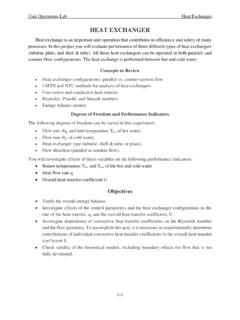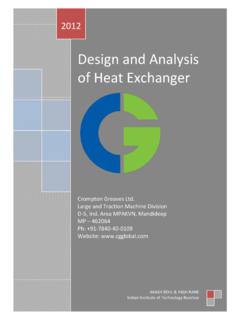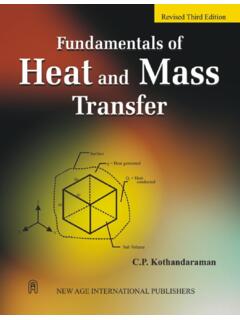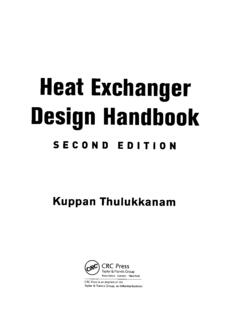Transcription of HEAT EXCHANGER - University of Florida
1 Unit Operations Lab heat EXCHANGER 1-1 heat EXCHANGER heat exchange is an important unit operation that contributes to efficiency and safety of many processes. In this project you will evaluate performance of three different types of heat exchangers (tubular, plate, and shell & tube). All these heat exchangers can be operated in both parallel- and counter-flow configurations. The heat exchange is performed between hot and cold water. Concepts to Review heat EXCHANGER configurations; parallel vs. counter-current flow LMTD and NTU methods for analysis of heat exchangers Convective and conductive heat transfer Reynolds, Prandtl, and Nusselt numbers Energy balance closure Degrees of Freedom and Performance Indicators The following degrees of freedom can be varied in this experiment.
2 Hot water feed temperature Th,i and flow rate Cold water feed temperature Tc,i and flow rate heat EXCHANGER type (tubular, shell & tube, or plate) Flow direction (parallel or counter-flow) You will investigate effects of these variables on the following performance indicators: Return temperatures Th,o and Tc,o of the hot and cold water heat flow rate q Overall heat transfer coefficient U Objectives Investigate effects of the control parameters and the heat EXCHANGER configuration on the rate of the heat transfer, q, and the overall heat transfer coefficient, U.
3 Check validity of the theoretical models. Investigate dependence of convective heat transfer coefficients on the Reynolds number and the flow geometry. To accomplish this goal, it is necessary to experimentally determine contributions of individual convective heat transfer coefficients to the overall heat transfer coefficient U. To isolate contribution of one of the coefficients, vary temperature of only one of the fluids. To obtain dependence of this coefficient on the Reynolds number, vary the flow rate of the corresponding fluid.
4 Unit Operations Lab heat EXCHANGER 1-2 Theory Notes 1. The theory presented here is based on Ref. 1. Please refer to this book for more details. 2. Subscripts h and c refer to the hot and cold fluids, respectively, and subscripts i and o refer to the inlet and outlet of the heat EXCHANGER , respectively. , Th,i denotes temperature of the hot fluid at the inlet and Tc,o denotes temperature of the cold fluid at the outlet. Overall heat Transfer Coefficient U Consider energy balance in a differential segment of a single-pass heat EXCHANGER shown schematically in Fig.
5 1-1. The rate of heat transfer in this segment is ,(1)where U is the overall heat transfer coefficient, T is the local temperature difference between the hot and cold fluids, and dA is the contact area in the differential segment. The overall heat transfer coefficient is inversely proportional to the total resistance Rtot to the heat flow. The latter is the sum of (1) resistance Rconv,h to convective heat transfer from the hot fluid to the partition between the fluids, (2) resistance Rp to thermal conduction through the partition, and (3) resistance Rconv,c to convective heat transfer from the partition to the cold fluid.
6 Therefore, 1 1 , , . (2) Figure 1-1. Energy balance in a differential element of a single pass heat EXCHANGER operated in the counter-flow regime. Red, blue, and gray colors represent the hot fluid, cold fluid, and the partition between the fluids, respectively. The dashed rectangle shows a differential segment corresponding to the energy balance Eq. (1). Three resistances (Rconv,h, Rp, and Rconv,c) contributing to the total resistance to the heat transfer are indicated schematically. Convective heat transfer.
7 Resistance to the convective heat transfer is inversely proportional to the convective heat transfer coefficient, h = 1/Rconv. The convective heat transfer Unit Operations Lab heat EXCHANGER 1-3 coefficient depends on fluid properties, flow geometry, and the flow rate. It is convenient to describe this dependence using several dimensionless numbers, namely the Reynold number , (3)the Prandltl number , (4)and the Nusselt number . (5) Here, , , k, and cp are the density, viscosity, thermal conductivity, and heat capacity of the fluid, v is the flow velocity, and L is characteristic length.
8 The choice of L depends on the system geometry. For example, for a flow in a circular pipe, L is the pipe diameter. Relationship between Re, Pr, and Nu depends on the system geometry and whether the flow is laminar and turbulent. For example, for a turbulent flow inside a pipe with circular cross-section of diameter D, . / (6)As a part of your pre-lab homework, you should find all correlations relevant to the geometries and the flow regimes considered in this experiment. Conductive heat transfer. The resistance Rp to heat transfer through the partition depends on the system geometry.
9 In the current experiment, you will need to consider heat conduction in the radial direction of a cylindrical tube and heat conduction across a thin plate. Resistances in both of these cases can be obtained analytically be solving the heat diffusion equation. You should obtain Rp for all considered heat exchangers as a part of your pre-lab homework. Relationships between Overall heat Transfer Coefficient and the Inlet and Outlet Fluid Temperatures In the previous section we discussed heat transfer in a differential segment of the heat EXCHANGER .
10 Here, we analyze the heat transfer in the entire heat EXCHANGER . heat exchangers are usually analyzed using either the Logarithmic Mean Temperature Difference (LMTD) or the effectiveness Number of Transfer Units ( -NTU) methods. The LMTD method is convenient for determining the overall heat transfer coefficient based on the measured inlet and outlet fluid temperatures. The -NTU method is more convenient for prediction of the outlet fluid temperatures if the heat transfer coefficient and the inlet temperatures are known.






